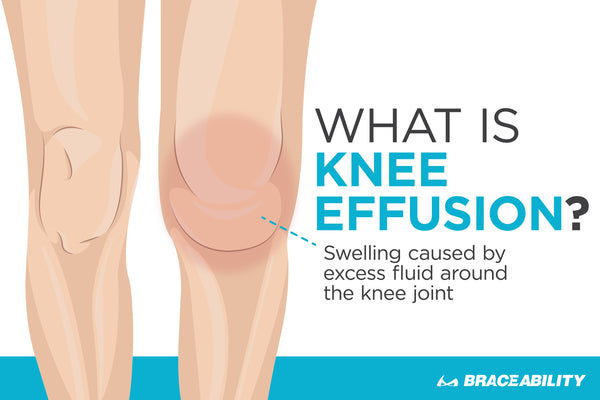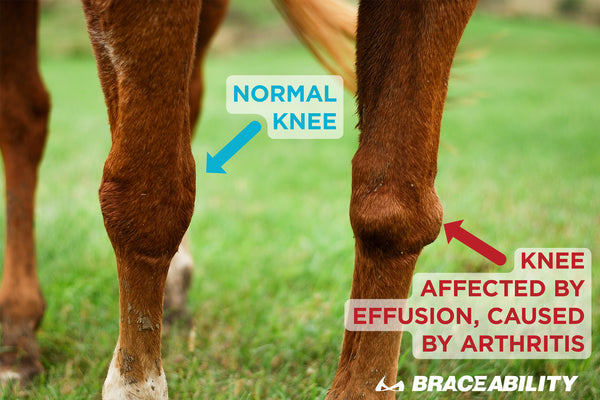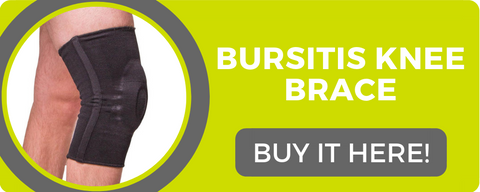Knee Effusion: Fluid or Water on the Knee
What is Effusion of the Knee?

To put it simply, effusion of the knee is the escape of fluid into the tissue. This occurs when excess fluid accumulates in or around the knee joint. A small amount of fluid naturally exists in normal joints, but when a joint is affected by arthritis, for example, abnormal amounts of fluid can build up causing the knee to become swollen around the top, outside and below your knee.

In the photo above, you can clearly see a horse that is affected by effusion of the knee. A horse's knee functions in a similar way to humans, which explains why the condition on a human looks the same as it does on a horse. This particular horse suffers from arthritis, causing effusion of its knee.
Water on the Knee vs. Bursitis: What's the difference?
It’s unclear what the difference between water on the knee, or effusion, and knee bursitis is, but we’ve uncovered why: they’re both the same thing. There is no difference between water on the knee and knee bursitis.
Knee bursitis is specifically explained as the inflammation of a small fluid-filled sac situated near your knee joint and around the kneecap. A bursa is the small sac that retains the fluid. The fluid that fills the bursa is called synovial fluid.
Other names for water on the knee:
- Effusion
- Knee Bursitis
- Prepatellar Bursitis
- Swelling of the knee
Water on the Knee vs. Swelling of the Knee: What is the difference?
There are two different types of swelling: edema and effusion. Edema is swelling that occurs primarily in the soft tissues of the body. Effusion is swelling or fluid in the joint space. So really, there is no difference between water on the knee and swelling of the knee. Effusion is just a specific type of swelling.
Symptoms of Effusion:
- Swelling and redness of the skin
- Joint stiffness
- Difficulty straightening leg
- Pain and tenderness
- Knee is warm/hot to the touch
- Fluid build up
- Knee is large and puffy
What causes fluid on the knee?
The two main causes of effusion of the knee:
- Arthritis
Arthritis is inflammation of one or more of your joints. There are actually over one hundred different forms of arthritis. The symptoms typically include pain, swelling, and stiffness.
- Injury to ligament
An injury to your ligament can occur in many different ways. Ligaments in your knees include the anterior cruciate ligament (ACL), the posterior cruciate ligament (PCL), the lateral collateral ligament (LCL), and the medial collateral ligament (MCL). This can occur while on a run or other strenuous activities. The symptoms typically include pain, a loud pop, swelling, looseness in the joint, and inability to bear weight without pain.
After any injury, swelling occurs because the body’s natural reaction is to surround the knee with a protective fluid. This is when effusion of the knee occurs.
5 ways to get rid of fluid on the knee:
Because effusion is caused by different conditions, the best treatment process may vary depending on the person.
- Home Remedy
It’s suggested that you use a medical knee brace to help compress the bursa and aid in treatment. Using the R.I.C.E. method can help to reduce swelling and pain in your knee at home. If your knee is not improving after using this method, it is highly suggested that you call your doctor.
- Physical Therapy
A Physical Therapist can advise exercises and fitness activities to strengthen the area that is affected and treat your knee. By keeping your leg strength, you help your knee to be stable and relieve pressure on the joint.
- Arthrocentesis
The doctor uses a needle to drain fluid out of the knee while the knee is numbed. This method helps to relieve pain, pressure and the appearance of swelling by minimizing the collection of fluid.
- Arthroscopy
During this method, the doctor will thread an arthroscope into the knee. An arthroscope is a flexible tube with a camera at the end of it. Tools can be passed through the tube to repair damage to the cartilage and remove loose tissue, hopefully curing your knee.
- Joint Replacement
In severe cases of osteoarthritis, the knee joint may need to be replaced with a prosthetic to relieve pain and improve function.











